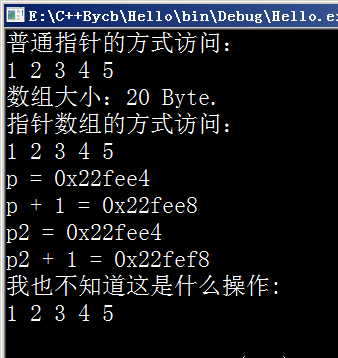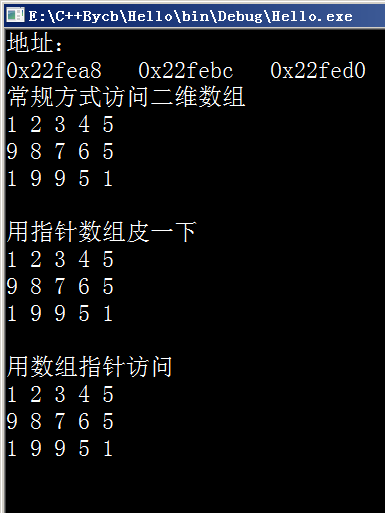一维数组:
1 #include <iostream>
2 using namespace std;
3 int main()
4 {
5 /**为了方便 数组的类型全部都是int类型的*/
6 int numbers[5] = {1,2,3,4,5};
7 /**通过指针的方式访问数组*/
8 int * p = numbers;
9 cout << "普通指针的方式访问:n";
10 for (int i = 0; i < 5; i++)
11 cout << p[i] << " ";
12 cout << endl;
13 /**
14 在这里面numbers 被解释为数组的第一个元素的地址 即 &numbers[0] 而且还是一个常量
15 也有特殊的情况,例如:sizeof numbers是数组大小
16 */
17 cout << "数组大小:";
18 cout << sizeof numbers << " Byte.n";// 5 * 4
19 /**通过数组指针的方式访问数组
20 数组的地址是 &numbers NOTE:这和numbers值是一样的!!!
21 也就是说相同的地址 你可以用普通的指针指向 也可以用数组指针指向
22 区别就在于他们的指针运算
23 */
24 int (*p2)[5] = &numbers;//把数组的numbers替换成(*p2)就是 数组的指针了
25 cout << "指针数组的方式访问:n";
26 for (int i = 0; i < 5; i++)
27 cout << (*p2)[i] << " ";
28 cout << endl;
29 /**
30 int * p 和 int (*p2)[5] 的区别
31 区别在于他们的指针运算
32 这里不明白的去百度 指针运算
33 */
34 cout << "p = " << p << endl;
35 cout << "p + 1 = " << p + 1 << endl;//4Byte
36 cout << "p2 = " << p2 << endl;
37 cout << "p2 + 1 = " << p2 + 1 << endl;//20 Byte
38 /**提到 数组指针 就必去提到另一个知识点 指针数组
39 数组指针 是 指针
40 指针数组 是 数组
41 定义的时候 二者通常会混淆
42 */
43 int * p3[5];//指针数组 每一个元素 都是指针
44 for (int i = 0; i < 5; i++)
45 p3[i] = (*p2) + i;//p2是数组指针 常作为二维数组的指针使用
46 cout << "我也不知道这是什么操作:n";
47 for (int i = 0; i < 5; i++)
48 cout << *p3[i] << " ";
49 cout << endl;
50 return 0;
51 }

二维数组:
1 #include <iostream>
2 using namespace std;
3 int main()
4 {
5 int data[3][5] =
6 {
7 {1,2,3,4,5},
8 {9,8,7,6,5},
9 {1,9,9,5,1}
10 };
11 /**二维数组的本质是 数组的数组、
12 第一维数组是3个一维数组的地址、第二维就是普通的数组*/
13 int * p[3] = {data[0], data[1], data[2]};
14 cout << "地址:n";
15 for (int i = 0; i < 3; i++)
16 cout << p[i] << " ";
17 cout << endl;
18 /**常规方式访问二维数组*/
19 cout << "常规方式访问二维数组n";
20 for (int i = 0; i < 3; i++)
21 {
22 for (int j = 0; j <5; j++)
23 cout << data[i][j] << " ";
24 cout << endl;
25 }cout << endl;
26 /**用指针数组尝试访问一下*/
27 cout << "用指针数组皮一下n";
28 for (int i = 0; i < 3; i++)
29 {
30 for (int j = 0; j < 5; j++)
31 cout << p[i][j] << " ";//这里之所以能访问是因为size是int
32 cout << endl;
33 }cout << endl;
34 /**用数组指针
35 int data[3][5] 的第一个元素就是data[0]那么他的 地址就是&data[0] 等价于data
36 前面说过data是属于的第一个元素的地址, 而且还是一个常量
37 那么问题来了 指向&data[0]的指针是什么样子的?
38 data[0] 的类型是int[5] 那么
39 &data[0] 的类型就是 int (*)[5]
40 */
41 int (*p2)[5] = data;
42 cout << "用数组指针访问n";
43 for (int i = 0 ; i < 3; i++)
44 {
45 for (int j = 0; j < 5; j++)
46 cout << p2[i][j] << " ";//这里参考一维数组的数组指针就能理解了
47 cout << endl;
48 }cout << endl;
49 return 0;
50 }

数组与函数:
1 #include <iostream>
2 using namespace std;
3 void print1(const int * p, int len);
4 void print2(const int p[], int len);
5 void print3(int p[][5], int len);//don't use const DON'T!!!
6 void print4(int (*p)[5], int len);//don't use const DON'T!!!
7 int main()
8 {
9 int numbers[5] = {1,2,3,4,5};
10 int data[3][5] =
11 {
12 {1,2,3,4,5},
13 {5,6,7,8,9},
14 {9,8,7,6,5}
15 };
16 print1(numbers, 5);
17 print2(numbers, 5);
18 print3(data, 3);
19 print4(data, 3);
20 return 0;
21 }
22 void print1(const int* p, int len)
23 {
24 cout << "print1n";
25 for (int i = 0; i < len; i++)
26 cout << p[i] << " ";
27 cout << endl;
28 }
29 void print2(const int p[], int len)
30 {
31 cout << "print2n";
32 for (int i = 0; i < len; i++)
33 cout << *(p + i) << ' ';
34 cout << endl;
35 }
36 void print3(int p[][5], int len)
37 {
38 cout << "print3n";
39 for (int i = 0; i < len; i++)
40 {
41 for (int j = 0; j < 5; j++)
42 cout << p[i][j] << ' ';
43 cout << endl;
44 }cout << endl;
45 }
46 void print4(int(* p)[5], int len)
47 {
48 cout << "print4n";
49 for (int i = 0; i < len; i++)
50 {
51 for (int j = 0; j < 5; j++)
52 cout << p[i][j] << ' ';
53 cout << endl;
54 }cout << endl;
55 }
56 /**
57 []([0]) 和 * 是相同的
58 * 就是[0]
59 p[5] 可以写成 * (p + 5)
60 p[5]实际做的事情就是先寻址然后在取值的过程
61 谭浩强老师在他的书里面讲过
62 */

补充:
1 #include <iostream>
2 using namespace std;
3 int main()
4 {
5 /**
6 const int * p 和 int * const p的区别
7 */
8 int a = 10;
9 const int b = 20;
10 const int * p1;// *p1 is read-only
11 p1 = &a;
12 cout << "p1 = " << p1 << endl;
13 cout << "&a = " << &a << endl;
14 cout << "*p1 = " << *p1 << endl;
15 //ERROR *p1 = 23;
16 p1 = &b;// p1 is not read-only
17 cout << "p1 = &bn";
18 cout << "*p1 = " << *p1 << endl << endl;
19
20 int * const p2 = &a;// p2 is read-only and must init it
21 //int * const p2 = &b;不匹配 因为没有保护数据
22 //const int * const p2 = &b; 这样可以
23 cout << "p2 = " << p2 << endl;
24 cout << "*p2 = " << *p2 << endl;
25 int c = 1222;
26 // p2 = &c; erro p2 is read-only
27 *p2 = 1234567;
28 cout << "*p2 = " << *p2 << endl;
29 cout << "p2 = " << p2 << endl;
30 return 0;
31 }

内容来源于网络如有侵权请私信删除
- 还没有人评论,欢迎说说您的想法!





 客服
客服


